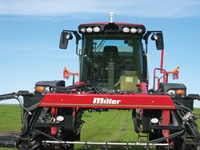March 21, 2011

That smartphone you carry on your hip now can deliver real-time weather reports direct from your farm, no matter where you are.
You also can view instantaneous in-field wind, temperature and humidity reports as you spray, thanks to a tiny mobile weather station mounted on the sprayer cowling.
Although automated weather stations have been around for years, the latest editions can automatically upload weather data to secure Web sites, ready for viewing from your cell phone or computer. Versions with built-in wireless or cellular communications make it possible to set up remote stations across a far-flung operation. This allows you to keep abreast of site-specific conditions to maximize the efficiency of weather-dependent field operations.
Meanwhile, mobile weather stations for use on vehicles have replaced fragile, twirling anemometers with durable ultrasonic wind speed sensors with no moving parts. Originally designed for yachts, these weather stations include GPS and an on-board computer to calculate actual wind speed as you drive.
Internet connected
An auto-reporting weather station uploads weather updates to a secure Web site through a personal computer or an Internet Protocol (IP) data logger. IP data loggers are available from many weather station manufacturers. They eliminate the need to have a PC turned on full time to upload ongoing weather data.
Various weather station manufacturers provide secure Web sites for uploading and viewing your weather data. Or you can stream live weather data to the Weather Underground (www.weatherunderground.com), WeatherBug (www.weatherbug.com) or the Citizen Weather Observer Program (www.wxqa.com). In general, these Web sites allow you to view current weather conditions, as well as archive and analyze historic weather data, which also can be downloaded to your computer. You can choose to share weather data with others or keep it private.
Weather stations offer wired or wireless packages for relaying weather data to your PC or IP data logger. A cellular or satellite modem that relays data directly to the Internet is another option.
Prices for IP weather stations range from hundreds to several thousand dollars. One option, the Weatherlink 6250 IP Vantage Vue wireless weather station, transmits weather data wirelessly up to 1,000 ft. to a data logger, which can upload weather conditions to a Web site every minute. The station that includes an IP data logger and related software is available for $600 to $700 from various online retailers. The non-IP version sells for about half as much. The systems are from Davis Instruments (www.davisnet.com).
The WeatherHawk 916 wireless weather station (www.weatherhawk.com) uses a 916-MHz spread spectrum radio for communication up to 1/2 mile to a host computer or data logger. Optional antennas can extend the range to more than 5 miles. The weather station sells for $2,500 to $3,000 or more, depending on options.
Mobile weather
In addition to measuring and computing wind speed and direction, the Watchdog Sprayer Station from Spectrum Technologies measures air temperature, humidity, dew point, wind chill and barometric pressure. Smaller than the size of a soda can, the sensor has a magnetic mount for easy installation. The full system includes a display console with built-in data logger, software and cable with vehicle power and serial connectors. Raven’s Viper Pro monitor also can display weather data from the sensor. The sensor and console package retails for $2,095. It is available at www.specmeters.com.
Topcon’s X20 weather station has similar capabilities, plus audible alerts for out-of-range conditions and the ability to record weather conditions within coverage maps. Available only for use with the X20 (System 200) console, it retails for $2,405. For details, visit www.topconpa.com.
New Mountain Innovations markets a system similar to the Watchdog. The NM150 Ultrasonic Weather Station with GPS retails for $1,899 with a 4-in. vehicle-mounted monitor and 12v interface. It is available at www.newmountain.com.
About the Author(s)
You May Also Like






